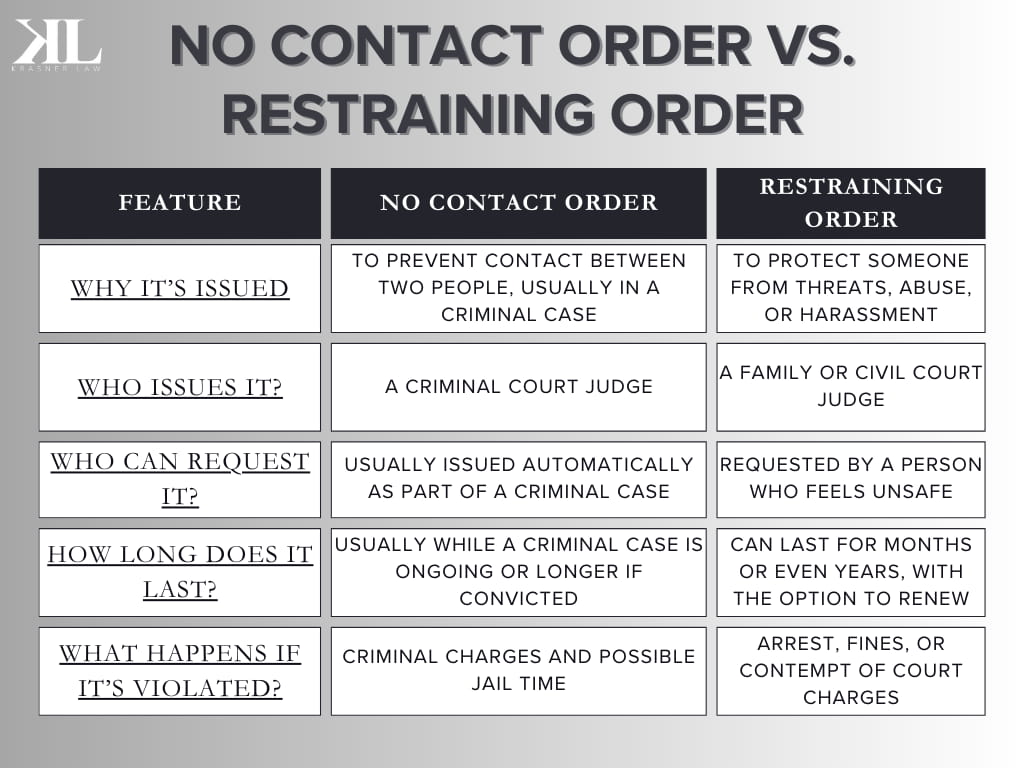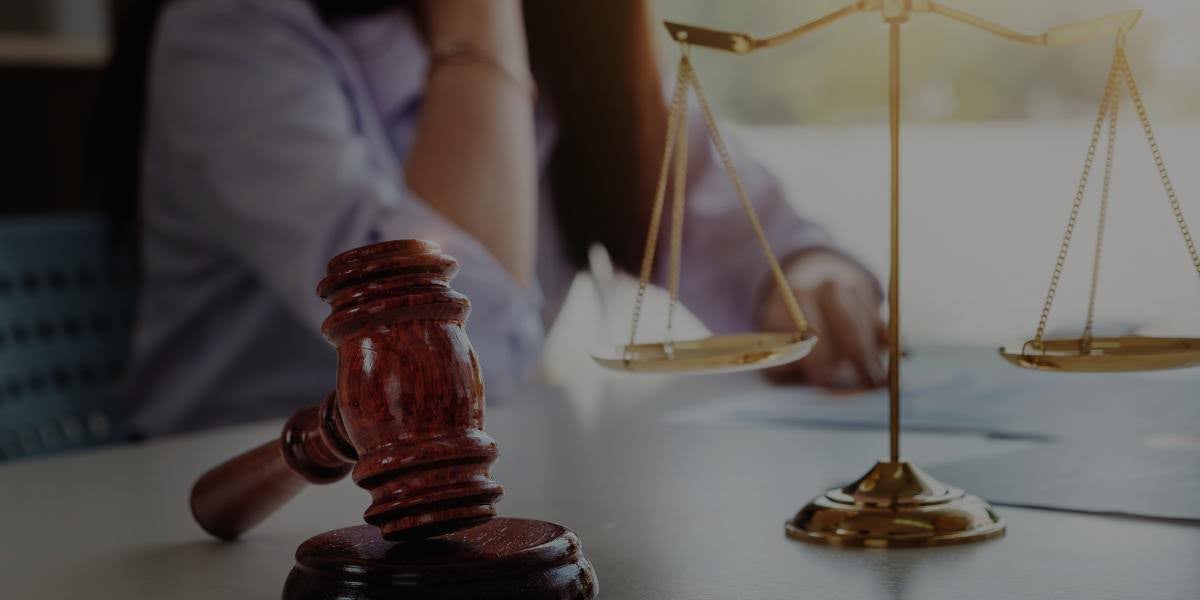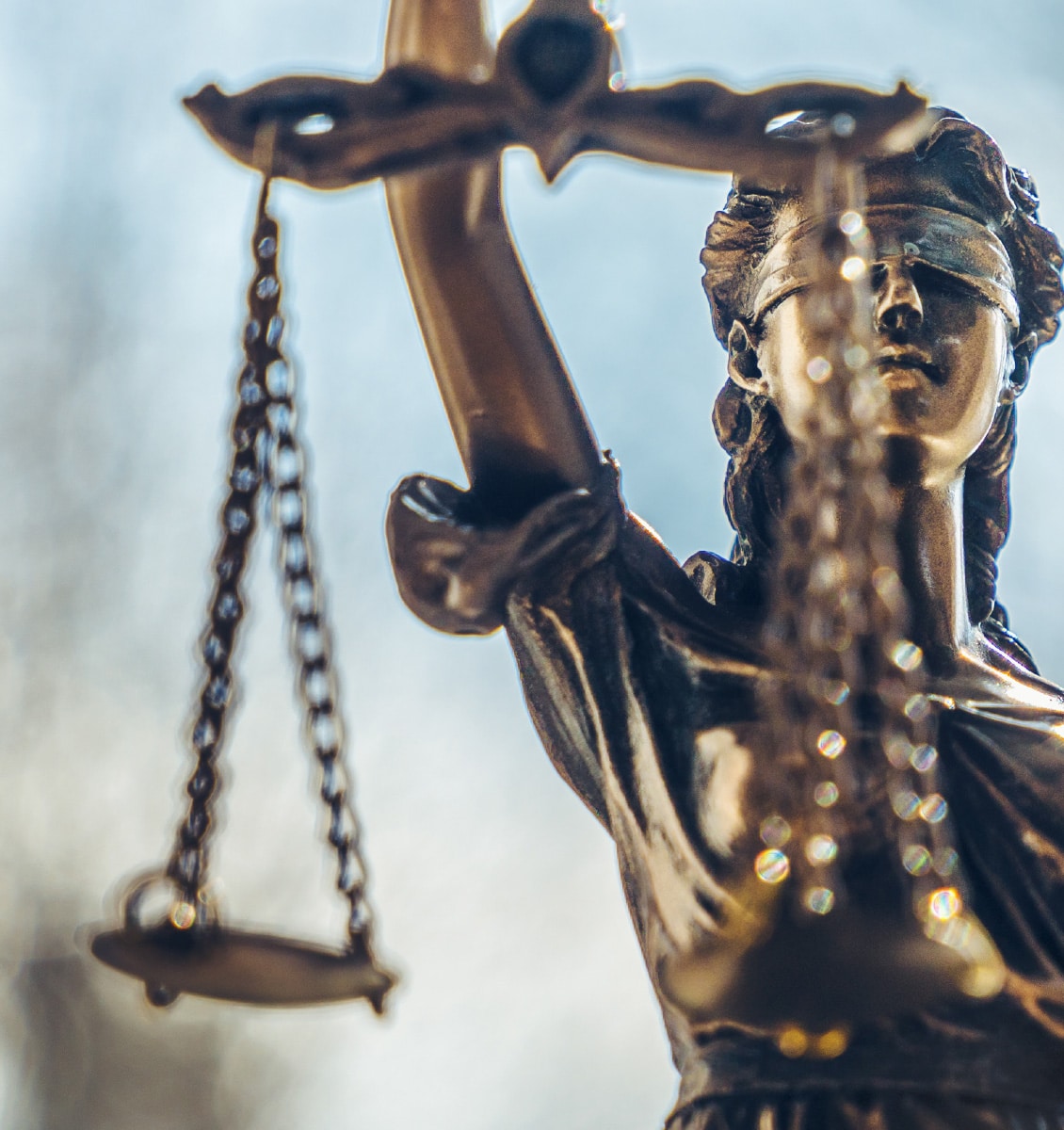If you’re dealing with a legal issue involving family disputes, domestic violence, or criminal charges, you might have heard the term no contact order. But what is a no contact order? A no contact order is a court order that prevents one person from communicating with another.
These orders are often put in place to protect people from harassment, threats, or harm. But they can also come with serious consequences if violated. In this blog, we’ll break down what a no contact order is, how it works, and the key differences between a no contact order vs. a restraining order so you can understand your rights and options.
What Is a No Contact Order?
A no contact order is a legal order from a court that prevents one person from communicating with another in any way. This means:
- No phone calls, texts, or emails
- No social media messages or interactions (even liking a post counts)
- No contact through mutual friends, family members, or coworkers
- No visiting the other person’s home, workplace, or school
- No sending gifts, letters, or indirect messages
A no contact order is often put in place to protect someone from potential harm, harassment, or intimidation. These orders are most commonly issued in criminal cases, especially those involving domestic violence, harassment, assault, or stalking.
When Is a No Contact Order Issued?
A judge may issue a no contact order in different situations, including:
- Domestic violence cases – If someone is accused of physically or emotionally harming a partner, spouse, or family member, a no contact order may be put in place to protect the alleged victim.
- Criminal charges – If someone is arrested and charged with assault, harassment, stalking, or similar offenses, the court may automatically issue a no contact order to prevent further harm.
- Ongoing investigations – Even if no charges have been filed yet, law enforcement or the court may put a temporary no contact order in place if there is concern about potential violence or threats.
- Bail or probation conditions – A judge may include a no contact order as part of the conditions for someone’s release on bail or while they are serving probation.
What Happens If You Violate a No Contact Order?
A no contact order is legally binding, meaning that breaking it can have serious consequences. If someone ignores the order and contacts the protected person, they could:
- Be arrested immediately – Police take violations seriously, and breaking a no contact order can lead to an automatic arrest.
- Face additional criminal charges – Violating a no contact order can result in extra charges, such as contempt of court or harassment.
- Receive harsher penalties – The court may increase fines, extend probation, or even sentence the violator to jail.
What If the Protected Person Wants Contact?
Sometimes, the person protected by the order may want to resume contact. However, even if both parties agree, the order remains in effect until a judge officially lifts or modifies it. If the protected person reaches out first, the respondent must still follow the order or risk legal consequences.
If both parties want to remove the order, they will need to go to court and file a formal request. A judge will review the case and decide whether it is safe and appropriate to lift the restriction.
Can a No Contact Order Be Dropped or Changed?
Yes, a no contact order can sometimes be modified or lifted, but it must be done legally. Here’s how the process typically works:
- Filing a motion – Either the protected person or the person under the order can file a request with the court to modify or drop the order.
- Court hearing – A judge will hold a hearing where both sides can explain why the order should (or shouldn’t) be changed.
- Judge’s decision – The judge will consider factors such as the safety of the protected person, the nature of the original case, and whether both parties are truly in agreement.
If the court decides the order should stay in place, both parties must continue to follow it.
What Should You Do If a No Contact Order Is Issued Against You?
If you find yourself under a no contact order, whether you agree with it or not, it’s important to take it seriously. Here’s what you should do:
- Follow the rules completely – Do not contact the protected person in any way, even if they reach out to you first.
- Understand the terms – Some no contact orders may allow indirect contact for legal or child custody matters. Make sure you know exactly what is permitted.
- Attend all court hearings – You may have opportunities to challenge the order or request modifications, but this must be done through the legal system.
- Talk to a lawyer – A criminal defense or family law attorney can help you understand your rights and guide you through the process.
What Should You Do If Someone Violates a No Contact Order Against You?
If you have a no contact order protecting you and the other person tries to reach out, take action immediately.
- Document everything – Save texts, emails, or any proof of attempted contact.
- Report the violation to the police – Law enforcement can take immediate action if the order has been broken.
- Inform your lawyer – If you have legal representation, let them know about the violation so they can help protect you.
Breaking a no contact order is a serious offense, and the court will not take it lightly.
No Contact Order vs Restraining Order: What’s the Difference?
A no contact order vs restraining order might seem similar, but they’re actually two different things.

Which One Do You Need?
- If someone has been charged with a crime, a no contact order is likely to be issued automatically by the court.
- If you are experiencing ongoing harassment or abuse and there is no criminal case involved, you may need to request a restraining order through civil court.
If you’re unsure which applies to your situation, speaking with a lawyer can help.
Can a No Contact Order Be Lifted?
A no contact order is a serious legal restriction, but in some cases, it can be modified or removed. However, this process is not automatic, and it requires legal steps to be taken. Whether you are the person protected by the order or the one under the order, you cannot simply decide to ignore it—even if both parties agree they want contact again.
The only way to lift or change a no contact order is through a court hearing and a judge’s approval. Here’s what you need to know if you want to modify or remove a no contact order.
Who Can Request a No Contact Order Be Lifted?
Either party involved in the order can request a change, but the process varies depending on the situation.
- The Protected Person (Victim): If you are the person the order is meant to protect and you no longer feel at risk, you can file a request to have the order modified or removed.
- The Accused Person (Respondent): If you are the person under the no contact order and you believe the order is unfair, unnecessary, or causing hardship, you can also request that the court modify or lift it.
However, the judge has the final say, and their decision will be based on several factors, including whether the order is still needed to ensure safety.
Steps to Get a No Contact Order Lifted or Changed
Since no contact orders are court-ordered, they cannot be lifted just by agreement between the people involved. The process requires several legal steps:
1. File a Request with the Court
The first step is to file a motion to modify or remove the no contact order. This is a formal legal request that must be submitted to the court that issued the order.
- The request should include the reasons why the order should be lifted or changed.
- If both parties agree to remove it, they may need to submit signed statements explaining why they want contact again.
- If only one person wants the order removed, they must explain why they believe it is no longer necessary.
What if the protected person wants the order lifted but doesn’t know how?
If you are the person protected by the order and you want it lifted, you may need to:
- Contact the court clerk for instructions on filing a motion.
- Work with an attorney to make sure the request is handled properly.
- Be prepared to explain to the judge why you feel safe resuming contact.
2. Attend a Court Hearing
Once a request is filed, the court will schedule a hearing where both parties can present their arguments. This is an important step because the judge needs to determine whether lifting or modifying the order is truly safe and appropriate.
- The judge will review the case history, including why the order was issued in the first place.
- The protected person may be asked if they feel safe and if they are making the request willingly.
- If there were previous violations of the order, the judge may be less likely to remove it.
- Both parties may need to provide evidence to support their request.
What if I can’t attend the hearing in person?
In some cases, courts allow virtual hearings, but you will need to check with the court in advance to see if this is an option. If you miss the hearing without a valid excuse, your request to remove the order will likely be denied.
3. The Judge’s Decision
After hearing from both sides, the judge will make a decision. They may:
- Lift the order completely – If the judge is convinced that the no contact order is no longer necessary, they may remove it entirely.
- Modify the order – The judge may allow limited contact, such as communication for co-parenting purposes, while still keeping other restrictions in place.
- Deny the request – If the judge believes the order is still needed for protection, they will keep it in place.
If the judge modifies the order instead of lifting it completely, they may change the restrictions, such as:
- Allowing text or email communication but still prohibiting in-person contact.
- Permitting contact only through a third party (such as a lawyer or mediator).
- Allowing communication for child-related matters only.
Regardless of the outcome, both parties must follow the court’s decision. If the order is lifted, the respondent is free to have contact again. If it remains in place, violating it can still result in serious legal consequences.
What is a no contact order and How Hard Is It to Get a No Contact Order Lifted?
The difficulty of lifting a no contact order depends on several factors:
- The seriousness of the original case – If the order was put in place due to domestic violence, assault, or repeated threats, the court is much less likely to lift it.
- Whether there were past violations – If the person under the order has broken the rules before, a judge may refuse to lift it.
- The protected person’s wishes – If the protected person requests to keep the order in place, the judge will likely honor their wishes.
- Time passed since the order was issued – If it has been a long time with no issues, the court may be more willing to reconsider.
Common Questions About Lifting a No Contact Order
What if both people want the order lifted?
Even if both parties agree, the court still has the final say. A judge will review the situation and decide if it is safe to allow contact again.
Can I get a no contact order lifted without going to court?
No, only a judge can modify or remove the order. You must go through the legal process to have it changed.
What if I ignore the no contact order and reach out anyway?
Even if the protected person wants to talk, the person under the order can still be arrested for violating it. The order is legally binding until a judge removes it.
How long does it take to remove a no contact order?
It depends on the court’s schedule, but it can take several weeks or months from the time you file a request to when a judge makes a decision.
Do I need a lawyer to remove a no contact order?
You don’t technically need a lawyer, but having one can help. A lawyer can:
- Make sure you follow the correct legal process.
- Help you present strong arguments in court.
- Increase your chances of getting the order lifted.
A no contact order is a serious legal restriction, and removing it requires a formal process. Whether you are the protected person who wants the order lifted or the respondent who wants to restore contact, the court must approve the request before any changes take effect.
Final Thoughts
A no contact order is a legal protection designed to keep people safe from unwanted contact, especially in criminal cases. While it may seem similar to a restraining order, the two have different legal purposes. If you need legal protection or have questions about a no contact order, talking to an attorney can help you understand your rights and next steps.
If you’re facing a legal situation involving a no contact order, Krasner Law is here to help. Contact us today to discuss your case and get the legal guidance you need.







